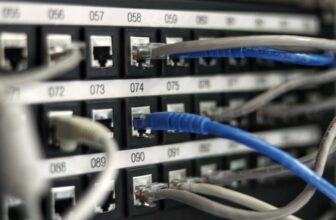
If you plan to set up a new network or upgrade an existing one, it’s essential to understand the differences between Cat6 vs Cat6a cables. While they may seem similar, some key differences could impact your network’s performance and reliability. This article thoroughly explains those differences to help you decide which cable suits your needs.
What is a Cat6 Ethernet cable?
A Cat6 Ethernet cable is a twisted pair cable for carrying Ethernet signals. It is an upgraded version of Cat5e and supports higher data transfer rates than its predecessor. Cat6 cables can transmit data at up to 10 Gigabits per second (Gbps) with a maximum distance of 55 meters, making them ideal for use in high-speed LAN (Local Area Network) environments.
What is a Cat6a Ethernet cable?
A Cat6a Ethernet cable is a type of Ethernet cable designed to support 10 Gigabit Ethernet (10GBASE-T) over a distance of up to 100 meters. The “a” in Cat6a stands for “augmented, ” meaning it has been improved over the original Cat6 standard to provide higher bandwidth, improved signal quality, and better performance. The main advantage of Cat6a Ethernet cables is their ability to support higher speeds and longer distances than other Ethernet cables. That makes them ideal for high-speed data centers, server rooms, and other applications where fast and reliable network connections are critical.
Cat6 vs Cat6a: What are the Differences?
Great, let’s compare Cat6 and Cat6a Ethernet cables based on the following key factors:
1. Bandwidth
Cat6 Ethernet cables have a maximum bandwidth of 250 MHz, while Cat6a Ethernet cables have a maximum bandwidth of 500 MHz. That means Cat6a cables can support higher data transfer rates over longer distances with less interference, making them a better choice for high-performance networks. Additionally, Cat6a cables are designed to support 10GBase-T Ethernet, which requires a higher bandwidth than Cat6 cables.
2. Speed
Although both cables support 10Gbps, they may support different distances. Cat6a can keep data transfer rates of up to 10 Gigabits per second (Gbps) at a maximum length of 100 meters, while Cat6 can transmit data at up to 10 Gbps but only up to a maximum distance of 55 meters.
3. Distance
For the 10Gbps, The maximum distance for Cat6 cables is 55 meters, while Cat6a supports 100 meters maximum distance. That means Cat6a is better suited for more extensive networks that require data transmission over longer distances without signal loss or degradation. Cat6 is ideal for smaller networks with shorter distances between devices. It’s important to note that the maximum distance for both cables depends on factors such as the quality of the cable, the environment, and the installation techniques used.
4. Shielding
Cat6a cables have better shielding than Cat6 cables. Both are in shielded twisted pair (STP) and unshielded (UTP) versions. STP cables have additional shielding to protect against interference. Cat6a STP cables have thicker shielding than Cat6 STP cables, while Cat6a UTP cables have a tighter twist rate than Cat6 UTP cables. However, UTP cables are generally less expensive and easier to install.
5. Crosstalk
Crosstalk is the interference between two adjacent wires in a cable. Both Cat6a and Cat6 cables have different levels of crosstalk. Cat6a cables have better crosstalk performance due to their thicker shielding and tighter twist rates. This results in less signal interference and better overall performance than Cat6 cables.
6. Cable and Installation Costs
When comparing Cat6 and Cat6a cable costs, it’s essential to consider the upgrade cabling costs. Cat6a cables are designed to support higher bandwidths and have a higher price tag than Cat6 cables. However, upgrading to Cat6a can be a wise investment for businesses or individuals requiring faster data transmission speeds and better network performance. The cost difference between the two cable types may vary depending on the vendor and package selected. Still, it’s generally worth it for those who require faster and more reliable internet connectivity.
Cat6 vs Cat6a: What are the Similarities?
Cat6 and Cat6a are both standards for Ethernet cables and share several similarities. Both offer faster data transfer rates than their predecessors, Cat5 and Cat5e. They are both backward compatible, meaning they can work with older devices compatible with Cat5 and Cat5e cables. Additionally, they both support the same maximum bandwidth capacity of 10 Gbps. These similarities make it easy for users to upgrade their network without worrying about compatibility issues. However, there are also significant differences between Cat6 and Cat6a that users should be aware of before deciding which one to use.
FAQs
Q: Is Cat6a better than Cat6?
A: Cat6a is better than Cat6 in terms of speed and bandwidth. It supports higher frequencies and longer distances, making it ideal for high-speed data transmission.
Q: Is Cat6a worth it for gaming?
Short answer: it is worth it. However, To optimize your gaming experience, consider all components of your wired LAN, including routers and connectors. Select the right router, cable type, and connector. Also, configure your CPUs and graphics cards to ensure optimal performance.
Q: Is Cat6a overkill?
Cat6a may be considered overkill for smaller networks or those with shorter distances between devices. However, for those who require faster data transfer rates, longer distances, and better performance, Cat6a is manageable.
Q: Is Cat6a better than Wi-Fi?
There are a few factors to consider when deciding between a wired connection using Cat6a or Wi-Fi. While Cat6a can offer faster and more dependable speeds, Wi-Fi provides greater device flexibility and mobility. Ultimately, the best choice will depend on your specific needs and preferences.
Final Words
In conclusion, understanding the differences between Cat6 and Cat6a Ethernet cables is crucial when setting up or upgrading a network. While both ethernet cables have similarities, the key differences in bandwidth, speed, distance, shielding, and overall performance can impact network reliability and speed. Which one suits your needs? Have you ever experienced issues with Ethernet cables in your network? What factors do you consider when choosing Ethernet cables?
Reference




